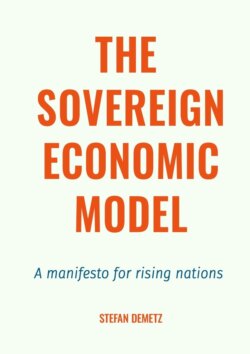Читать книгу The Sovereign Economic Model. A manifesto for rising nations - Stefan Demetz - Страница 21
State capitalism
Capital, the Real Economy, and Wealth Creation in State Capitalism
ОглавлениеCapital is a required element for wealth creation. State capitalism, by ownership and control of strategic industries, makes sure that capital, as profits, gets reinvested in industries that create wealth. State capitalism effectively monopolizes rent-seeking industries and market sectors, which produce most capital in the form of profits and dividends. A state can use that profit to reinvest in the real economy’s industries and reduce non-working capital in the economy.
Through such investment, state capitalism can be an effective strategy for economic development. One shortfall of liberal capitalism is that it is not aligned with the needs and strategic direction of a country: private businesses just chase profit or money accumulation. Usually in liberal capitalism, this is obviated by legislation and taxation to encourage private businesses to invest and enter a specific market segment. This investment is rarely encouraged to effectively meet a need, but more for declaring success by showing off highly questionable GDP numbers. In capitalism, money, like water, flows where there is less resistance and gives higher returns. So investors prefer to invest in fast food or coffee chains instead of in big industrial enterprises, which come with higher risk, longer production times, and fewer returns. Money, like water, can flow where it is unnecessary, where it does not bring benefits to the country, its people, and the wider local community. More refined forms of state capitalism as practiced in the Sovereign Economic Model are comparable to the management of water resources, such as riverbeds, basins, and coasts. Water, like money, must be directed in ways that create not disasters, but benefits to the local community.
State Capitalism 3.0 is the latest upgrade and current version. At the present moment, it is viewed as the third version after two iterations in the 19th and the 20th centuries. Currently, it is practiced to meet the following goals:
• Protect the financial markets from globalization and foreign ownership.
• Create a central bank to protect the national banking institutions.
• Progress development to the level of the most advanced countries.
• Establish a hybrid state capital.
• Promote state-led capital accumulation.
Several types of state capitalism exist. It has many forms, depending on the country and mindset:
• Some are derived from geopolitical issues, with sanctions and trade wars pushing a country to adopt passive or active forms to fight off foreign countries and their companies.
• Ideological state capitalism is more inclined to stabilization and socially relevant topics like protection of society from financialization and globalization.
• Protectionist state capitalism is more preoccupied with defending the market from foreign invasion.
• Competitive state capitalism uses this form to compete, often unfairly, with other countries.
No prescribed model of state capitalism exists and there is no formula to define which is best or even what works. The best model to use is tailor-made for the country and brings the greatest benefits to its economy.
